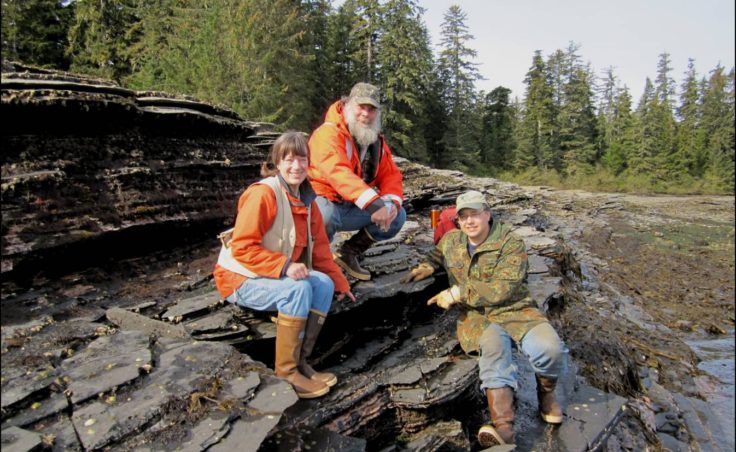The fossil of a Thalattosaur discovered near Kake two years ago is a complete specimen, the first to be found in the western hemisphere. Scientists speculate it could be a new species of the prehistoric marine reptile.
The fossil was found along the shores of Keku Island near Kake the summer of 2011. It was excavated in two rock slabs from an outcrop with the hope they would reveal a complete Thalattosaur, a marine reptile that inhabited the seas 210 million years ago. The rocks were stored at the University of Alaska Museum of the North in Fairbanks.
It wasn’t until earlier this year that earth sciences curator Pat Druckenmiller got a fossil preparator to work on them.
“We knew that we had sort of the tail end of the animal and it was going into the rock but we didn’t know how far in it went or if we had all of it. When he came up, we said, ‘Well, let’s just start cleaning in this area where we think roughly the skull might be,’ and bingo, it was right on top of the skull,” Druckenmiller says.
In the next week, fossil preparator J.P. Cavigelli from Wyoming worked to uncover about half of the skull from the tip of the nose to the eye socket.
All under a microscope, Cavigelli used handheld jackhammers and a small hand blaster to do his work.
“It’s fairly tricky because the rock and the bone are almost the same colors. It’s a very subtle change which is why you have to do it all under the microscope. By the time you get the last layer of rock off with the sandblasting outfit, it’s hard to see unless you know what to look for,” explains Cavigelli.
Cavigelli has prepared various fossils but this one is unlike any he’s encountered before.
“I’ve never done anything Triassic. I’ve never done such a complete small animal like that. I should say I’ve done some fishes but fishes – bah – a fish is a fish. This is a reptile, much more exciting,” Cavigelli says.
“It was like an iguana. It basically had the ability more than likely to come in and out of the surf and feed. And it was about three feet in length,” says Tongass National Forest geologist Jim Baichtal, who was part of a group that discovered the Thalattosaur fossil more than two years ago.
“From anything outside of China, this is the only full specimen that exists, which is really exciting for us. It’s a key thing in the evolution of this branch of marine reptile,” Baichtal says.
Baichtal says pieces of fossilized Thalattosaur bones had been discovered in Southeast Alaska before, but never a complete specimen. “The Thalattosaur that we just recently discovered must have floated down quietly to the bottom of the ocean and laid there. It didn’t come tumbling down and disarticulated and break apart.”
Museum of the North curator Druckenmiller says having a complete skeleton this well preserved allows more to be discovered about the Thalattosaur.
“First impressions from what can we see of the parts that we have cleaned suggest that this is unlike any other Thalattosaur that’s known from, say, Europe or China. It’s very likely we may have a new species.”
Baichtal describes further, “All of the thalattosaurs that have been discovered have teeth all the way out to the end of their rostrum or their nose or their jaws, and the one that we have actually has no teeth out to the end at all.”
Druckenmiller says Cavigelli will be back this winter to uncover the rest of the fossil. He hopes there’s evidence of where the skin or body outline used to be.
“The other thing that would be entirely possible on a skeleton this well preserved is actually to preserve stomach contents and to get direct evidence of diet, and for an animal like this that we know really very little about and that has such strange skull and teeth, that would be really, really important information,” says Druckenmiller.
Once the specimen is cleaned up, Druckenmiller will start comparing it to other Thalattosaurs.
If it is indeed a new species, Druckenmiller, Baichtal, and others involved will get to come up with a new name for it. Druckenmiller says the fossil will be displayed at the Museum of the North.
Baichtal hopes a cast of the Thalattosaur will make its way back to Southeast Alaska where residents can enjoy a fossil that came out of rocks from their own backyard.


